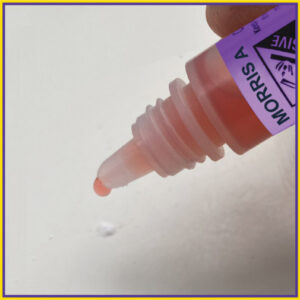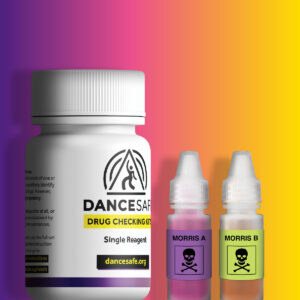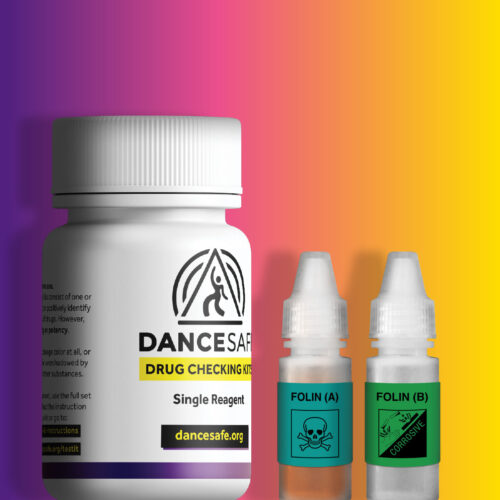Ketamine Testing Kit
$20.00
DanceSafe’s ketamine test kit consists of a single two-part reagent called Morris. The two parts, Morris A and Morris B, come in separate dropper bottles, and should be used together on one sample.
Morris is currently the only kit on the market able to distinguish ketamine from DCK, 2-FDCK, and other novel dissociatives. Morris also turns a bright Jolly Rancher blue in the presence of cocaine. (Morris does not work the same as other reagents. See detailed instructions below before use.)
Each kit performs 50-75 tests.
Shipped discretely. Overnight shipping available. More info
Automatic bulk discounts:
5+ reagents: $15 each
10+ reagents: $12.50 each
30+ reagents: $10 each
Mix and match okay. Discounts automatically applied at checkout. Preexisting sets of reagents are not included, since they are available in our store for a discounted price.
- Description
- Additional information
Description
As ketamine has become more popular, an increasing number of drugs are being misrepresented and sold as ketamine. These include ketamine analogs (drugs that are chemically similar, but unique), PCP analogs, other novel dissociatives, and sometimes drugs with completely different effects. These substances all have different durations, dosages, and risk profiles.
Note: Mandelin reagent has been used to test ketamine in the past, but it is often inconsistent and can produce similar reactions with many other drugs. We no longer recommend using Mandelin reagent to test ketamine.
Read our “reagent drug checking instructions” page FIRST to learn how to test correctly. Our full instruction pamphlet is also included as a physical copy with your order.

Step 1:
On a white ceramic plate, put a drop of the pink liquid (bottle A) onto a small amount of your sample. We recommend using at least 5-10 mg of material (more than other reagents require) to get an accurate reading.

Step 2:
Put a drop of the clear liquid (bottle B) on the same sample. Your sample should now have a drop of Morris A and a drop of Morris B on it. Blue speckles may appear, but your test isn’t done yet.

Step 3:
Stir the mixture with a toothpick or the sharp point of a knife for a full 30 seconds.

Step 4:
After stirring, compare the resulting color with the images below.
Note: After putting the first drop (bottle A) onto your sample, you may see blue specks appear. Ignore these; many substances turn blue after the first drop. You’ll only see the final color after putting a drop of B on the sample too, and then stirring the mixture for 30 seconds.

Note: Although still very rare, we have confirmed a handful of cases of ketamine being contaminated with fentanyl. The drug market can change rapidly and it’s unclear whether this will become more common. Whenever possible, use our fentanyl test strips to test your ketamine taking it.
Most reagents contain acids that break down the molecules in a drug sample through a chemical reaction, dissolving the drug entirely and producing a color change almost immediately. Morris reagent is different because it simply comes in contact with the molecules and changes colors if those molecules belong to specific drugs (like ketamine).
This is why you need to stir the mixture after you’ve put one drop of both Morris A and Morris B onto the sample. Stirring mixes the two solutions together so you can see the proper and final color. Use a toothpick or the point of a sharp knife, and stir thoroughly for a full 30 seconds.
Ketamine is the only drug we know of that turns purple in the end. Most drugs don’t react at all, and end up a dull green color. This is the color you will see if you combine one drop of each liquid together, with no drug sample. We call this a “blank.” You may find it useful to put a blank on your plate first, to see what a “non-reaction” looks like. The vast majority of drugs will not react with Morris reagent.

When you drop Morris A (the pink liquid) onto your sample, you may see specks of blue appear, as in the above photo on the right. Ignore this – many substances will do this. Only after 1) adding a drop from the second bottle (Morris B) and 2) stirring for 30 seconds will you see the proper and final color.
Caution: At least one company sells a version of Morris reagent that’s primarily marketed to law enforcement, and their product consists of small ampules that you break open inside a clear, plastic pouch. This method does not work. It does not reveal enough color detail to distinguish between various drugs, and can often produce false positives. Do not use a test tube. You must use a white plate (ideally ceramic or hard plastic) as your testing surface and stir the mixture as described above.
Although we tested dozens of drugs with Morris reagent and none of them reacted like ketamine – most didn’t react at all – there may be some drugs we haven’t tested that do turn purple, or that produce a unique color of their own. If you discover a drug that reacts with Morris reagent (that does not turn dull green), please email a photo of the reaction to eman@dancesafe.org.
We tested the following novel dissociatives and only two of them, deschloroketamine (DCK) and 2-fluoro-deschloroketamine (2-FDCK), reacted at all. They both turned a dark blue/gray color. All the others turned dull green, indicating a non-reaction. The following dissociatives are non-reactive:
• phencyclidine (PCP)
• deschloro-n-ethyl-ketamine (2-OXO-PCE)
• 3-methoxy-PCP (3-MeO-PCP)
• 3-chloro-PCP (3-Cl-PCP)
• 3-methoxy-PCE (3-MeO-PCE)
• 2-oxo-PCE (O-PCE)
• methoxpropamine (MXPr)
• methoxetamine (MXE)
• ephenidine (EPE)
• diphenidine (DPD)

Copyright © 2021, 2022 DanceSafe, Inc.
Additional information
| Weight | 0.07 lbs |
|---|---|
| Dimensions | 3.75 × 1.75 × 1.75 in |









